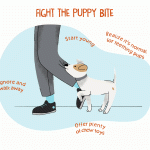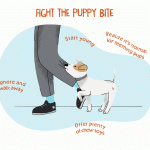To train a dog not to bark, use positive reinforcement, ignore the barking, and provide mental and physical stimulation. Consistency and patience are key.
Address any underlying issues causing the barking, such as anxiety or boredom. Now, let’s delve into the effective strategies for training your dog not to bark excessively. Barking is a natural behavior for dogs, but excessive barking can be disruptive and stressful.
Fortunately, with the right approach, you can train your dog to bark less. Whether you have a new puppy or an older dog, teaching them not to bark excessively requires patience and consistency. By understanding the root causes of their barking and using positive reinforcement techniques, you can effectively train your dog to be quieter and more calm. In this guide, we’ll explore practical tips and strategies to help you address your dog’s barking behavior in a positive and effective manner.

Credit: www.wikihow.pet
Introduction To Bark Training
Bark training is an essential part of dog obedience. Teaching a dog not to bark excessively can prevent disturbances and maintain a peaceful environment. Effective methods include positive reinforcement, consistent training, and identifying the root cause of barking.
Why Dogs Bark
Dogs bark to communicate, express emotions, alert danger, or seek attention.
Benefits Of Training Your Dog To Be Quiet
Training your dog to be quiet improves your relationship and creates a peaceful environment.
Why Dogs Bark
Dogs bark to communicate, express emotions, alert danger, or seek attention.
Benefits Of Training Your Dog To Be Quiet
Training your dog to be quiet improves your relationship and creates a peaceful environment.

Credit: www.youtube.com
Assessing The Barking Behavior
To train a dog not to bark, start by assessing the barking behavior triggers. Use positive reinforcement techniques and consistency to redirect the behavior. Engage in regular training sessions to reinforce quiet behavior and discourage excessive barking.
If your dog barks excessively, it can be frustrating and disruptive. However, before you start training your dog not to bark, you need to assess the barking behavior. This will help you understand why your dog is barking and how to train them effectively. In this section, we will discuss how to identify triggers for barking and understand the different types of barking.Identifying Triggers For Barking
The first step in assessing your dog’s barking behavior is to identify what triggers their barking. Dogs may bark for a variety of reasons, including boredom, anxiety, fear, excitement, or to alert you to something. Some common triggers for barking include:- People walking by the house
- Other dogs barking
- Doorbell ringing
- Someone coming to the door
- Car doors slamming
Understanding Different Types Of Barking
Not all barks are created equal. Different types of barking can indicate different emotions and behaviors in your dog. Understanding the different types of barking can help you address the root cause of your dog’s barking.| Type of Barking | Description |
|---|---|
| Alert Barking | Barking to alert you to something, such as someone at the door. |
| Attention-Seeking Barking | Barking to get your attention, such as when you are not paying enough attention to your dog. |
| Anxiety Barking | Barking due to anxiety or fear, such as when left alone or in unfamiliar situations. |
| Play Barking | Barking during playtime or when excited. |
| Territorial Barking | Barking to protect their territory, such as their home or yard. |
Setting Up For Successful Training
Setting up for successful dog training involves effective techniques to address excessive barking. Discover practical tips and strategies to train your dog not to bark, promoting a peaceful environment and harmonious relationship with your furry friend.
Choosing The Right Training Environment
When it comes to training your dog not to bark, setting up the right environment is crucial for successful training. Choosing a suitable location will help minimize distractions and allow your dog to focus on the training exercises. Here are a few factors to consider:
- Noise Level: Find a relatively quiet area where external noises won’t disrupt your training sessions.
- Familiarity: Opt for a location where your dog feels comfortable and at ease, such as your backyard or a quiet room in your house.
- Minimal Distractions: Ensure the training area is free from distractions like other animals, toys, or food that may divert your dog’s attention.
Essential Tools And Treats For Training
Having the right tools and treats at your disposal is essential for effective dog training. Here are some items you’ll need:
- Leash and Collar: A sturdy leash and well-fitted collar will give you control and help guide your dog during training exercises.
- Clicker: A clicker is a useful training tool that emits a distinctive sound to mark desired behaviors.
- Treats: High-value treats that your dog finds irresistible will serve as positive reinforcement during training sessions. Make sure to choose treats that are small, soft, and easy to chew.
- Training Toys: Interactive toys can be used as rewards or distractions during training exercises, keeping your dog engaged and motivated.
Remember, using positive reinforcement techniques and rewards is key to training your dog not to bark excessively. By creating a suitable training environment and equipping yourself with the right tools and treats, you’ll be well-prepared to embark on a successful training journey with your furry friend!
Establishing The ‘quiet’ Command
Training your dog not to bark excessively can be achieved through the establishment of the ‘Quiet’ command. By teaching your dog this command, you can effectively communicate when they should stop barking.
Introducing The Command In A Calm Setting
- Choose a quiet environment to introduce the ‘Quiet’ command.
- Ensure minimal distractions to focus your dog’s attention.
Step-by-step Guide To Teaching The ‘quiet’ Command
- Start by commanding ‘Speak’ to encourage barking.
- Once your dog barks, show them a treat to associate with the behavior.
- Transition to the ‘Quiet’ command by showing the treat and saying ‘Quiet’.
- Wait for your dog to stop barking, then reward them with the treat.
- Repeat the process consistently to reinforce the ‘Quiet’ command.
Positive Reinforcement Techniques
To train a dog not to bark, positive reinforcement techniques can be effective. Consistent rewards for good behavior, such as treats or praise, can help the dog associate silence with positive outcomes. Redirecting the dog’s attention to a toy or game can also be useful in distracting them from barking.
The Role Of Rewards In Training
When it comes to training a dog not to bark excessively, positive reinforcement techniques can be highly effective. Using rewards to reinforce good behavior is a humane and effective way to train your dog. Rewards can include treats, praise, and playtime, and should be given immediately after your dog exhibits the desired behavior. This helps your dog make the connection between their actions and the reward they receive, encouraging them to repeat that behavior in the future.Timing And Consistency In Reinforcement
Consistency is key when it comes to using positive reinforcement to train your dog not to bark. Reinforcement should be immediate, consistent, and predictable. This means that every time your dog exhibits the desired behavior, they should receive a reward. It’s also important to be consistent with your training methods and to use the same rewards every time. This helps your dog understand what is expected of them and reinforces the behavior you want to see.Examples Of Positive Reinforcement Techniques
There are several positive reinforcement techniques that can be used to train your dog not to bark excessively. These include:- Clicker training: Using a clicker to mark the desired behavior and then giving your dog a reward.
- Target training: Teaching your dog to touch a specific object or spot, and then rewarding them for doing so.
- Desensitization: Gradually exposing your dog to the stimuli that trigger their barking and rewarding them for remaining calm.
- Redirecting: Teaching your dog an alternative behavior to perform instead of barking, such as sitting or lying down, and rewarding them for doing so.
Dealing With Stubborn Barking
To train a dog not to bark, consistent positive reinforcement and redirection techniques are key. Address the root cause of the barking behavior and provide mental and physical stimulation to keep your dog engaged and less likely to bark unnecessarily.
Implementing a structured training routine will help your dog understand when barking is appropriate.
Common Mistakes To Avoid
When dealing with stubborn barking, it’s important to avoid common mistakes that could inadvertently reinforce the behavior. One common mistake is responding to the barking with anger or frustration, as this can escalate the situation. Another mistake is inadvertently rewarding the barking behavior by giving the dog attention or treats when they bark. It’s also crucial to avoid using punitive methods, as these can lead to fear and anxiety in the dog, exacerbating the barking issue.
Strategies For Persistent Barkers
Dealing with persistent barking requires a strategic approach. Consistent training is essential, focusing on positive reinforcement for quiet behavior. Identifying triggers for the barking and addressing them can also be effective. Providing mental and physical stimulation through activities and toys can help reduce excessive barking. Using desensitization techniques to gradually acclimate the dog to the triggers of their barking can also be beneficial. Seeking professional guidance from a certified dog trainer or behaviorist may be necessary for particularly challenging cases.
Advanced Training And Socialization
When it comes to advanced training and socialization, it’s important to focus on reducing your dog’s barking behavior. This can be achieved through effective socialization techniques and incorporating the ‘Quiet’ command in various public settings.
Socializing Your Dog To Reduce Barking
Socializing your dog plays a crucial role in reducing excessive barking. Exposing your dog to different environments, people, and other animals from an early age can help them become more comfortable and less prone to barking out of fear or anxiety.
- Introduce your dog to various social settings such as parks, dog-friendly events, and pet-friendly establishments.
- Gradually increase the level of exposure to different stimuli, ensuring your dog remains calm and relaxed throughout the process.
- Encourage positive interactions with other dogs and people to foster a sense of security and confidence in your dog.
Incorporating The ‘quiet’ Command In Public Places
Teaching your dog the ‘Quiet’ command and implementing it in public places can significantly reduce unwanted barking. This advanced training technique can be effective in various settings, such as outdoor cafes, parks, and busy streets.
- Start by reinforcing the ‘Quiet’ command in familiar and controlled environments, gradually progressing to more challenging public settings.
- Use positive reinforcement, such as treats and praise, to reinforce the desired behavior when your dog responds to the ‘Quiet’ command in public places.
- Consistency is key in ensuring your dog associates the ‘Quiet’ command with remaining calm and composed in diverse social situations.
Troubleshooting And Adjusting Your Approach
When training your dog not to bark, it’s important to be flexible and adaptable. Not all dogs respond to the same training methods, so troubleshooting and adjusting your approach is crucial for success. Here are some key considerations to keep in mind as you refine your training strategy.
When To Seek Professional Help
If your dog’s barking behavior persists despite consistent training efforts, it may be time to seek professional assistance. A qualified dog trainer or behaviorist can provide personalized guidance and support to address your dog’s specific needs.
Adapting The Training To Your Dog’s Unique Personality
Each dog has a unique personality and temperament, so it’s essential to tailor the training approach to suit your dog’s individual traits. Whether your dog is highly energetic, easily distracted, or particularly sensitive, adjusting the training methods to align with their personality can lead to more effective results.
Maintaining Silence: Long-term Strategies
When it comes to training a dog not to bark, maintaining silence requires long-term strategies that involve consistent daily routines and ongoing training and reinforcement. These strategies are essential for instilling quiet behavior in your furry friend.
Daily Routines To Encourage Quiet Behavior
- Establish a regular feeding schedule to promote calmness and reduce unnecessary barking.
- Provide adequate exercise to expend excess energy, decreasing the likelihood of incessant barking.
- Utilize interactive toys and mental stimulation to keep your dog engaged and less prone to barking out of boredom.
Ongoing Training And Reinforcement
Consistency is key when it comes to ongoing training and reinforcement. Positive reinforcement through treats and praise for quiet behavior helps solidify the training. Redirect your dog’s attention when they are about to bark, and reward them when they remain silent. Consistent practice in various environments will help reinforce the desired behavior.
:strip_icc()/puppy-barking-2804577-f7f6bffd80fa4edca1bd247ba52fc0a6.jpg)
Credit: www.thesprucepets.com
Frequently Asked Questions
Can Dogs Be Trained Not To Bark?
Yes, dogs can be trained not to bark. Consistent positive reinforcement and appropriate training techniques can help control excessive barking behavior. Training methods such as desensitization and counter-conditioning can be used to teach dogs alternative behaviors and reduce barking triggers.
How Do I Get My Dog To Stop Barking At Everything?
To stop your dog from barking at everything, use positive reinforcement training techniques and provide mental and physical stimulation. Consider professional obedience training and consult a veterinarian to rule out any underlying medical issues. Consistent training and patience are key to changing this behavior.
How Do You Discipline A Dog To Stop Barking?
To discipline a dog to stop barking, use positive reinforcement, such as treats or toys. Ignore the barking to avoid reinforcing it. Provide mental and physical stimulation to prevent excessive barking. Consult a professional trainer for guidance if needed.
How Do You Stop Nuisance Barking?
To stop nuisance barking, identify the cause and address it. Use positive reinforcement training and provide mental and physical stimulation. Consider anti-bark collars or seek help from a professional trainer.
Conclusion
Training your dog not to bark requires consistency, patience, and positive reinforcement. By understanding the root cause of barking and using effective training techniques, you can successfully curb this behavior. Remember to be gentle, persistent, and celebrate progress along the way to a quieter, happier pup.



